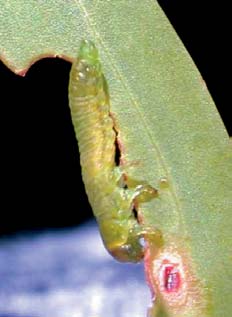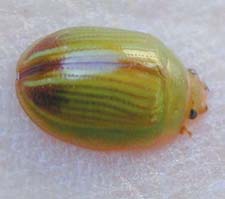PESTS AND DISEASES OF FORESTRY IN NEW ZEALAND
Peltoschema suturalis
No sign of unwanted beetle in Wellington
From Biosecurity 41, February 2003.
The Forest Biosecurity team is a step closer to announcing the eradication of another forestry pest.

Surveillance for an exotic chrysomelid beetle (Peltoschema suturalis), first discovered on several trees at Hataitai Park in October 2000 during routine risk site inspections, was repeated in late 2002. No beetles were found.
A native of Australia, the beetle is regarded as a minor pest of phyllode Acacia trees – host species include A. melanoxylon and A. longifolia. The dome-shaped beetle resembles a large green ladybird.
Since the original find, one repeat survey has been undertaken, along with monthly spot checks of host trees in Hataitai Park and surrounds. In November 2001, during the repeat survey one infested tree was found with three adult beetles. The infested tree and surrounding hosts were subsequently treated with an insecticide.
The most recent survey covered about the same area as the extended survey zone in 2001. Good results were achieved with no beetles or evidence of activity found.
To ensure that eradication has been successful, monitoring of the original infested area will be carried out up to five times per year, as part of the current risk site inspections of the Wellington region.
Mark Ross, National Adviser Pest Surveillance and Response, Forest Biosecurity
Australian pest down but not out in Wellington
From Biosecurity Issue 32, 15 December 2001.
Rigorous surveillance of host trees in Wellington’s Hataitai Park resulted in only three adult Peltoschema suturalis beetles being found on just one wattle tree.
Peltoschema suturalis is a minor insect pest of wattles and is native to Australia. MAF contractors first found the beetle population during a routine survey of Wellington risk sites in October 2000. Up until the November survey, no further evidence of the pest had been found (Biosecurity 31:15).

The surveillance zone includes all host trees within a 500 metre radius of the finds, as well as wattles located on some industrial sites around Wellington Airport. It takes the VIGIL, Forest Research contractors four days to inspect the trees for signs of the pest.
Following confirmation of the three beetles, MAF decided to extend the survey zone. A further 90 trees were inspected but no more finds were made. The infested tree and five surrounding host trees were successfully treated with insecticide immediately following the survey.
The insect appears limited to one specific area of Hataitai Park, and MAF will continue to undertake monthly inspections of all identified trees. A full survey will be repeated in October 2002.
Local residents and the Wellington City Council continue to prove very cooperative, which greatly assists with the survey. Unlike surveys in other residential areas of New Zealand, no dog attacks were reported.
Mark Ross, National Adviser, Forest Pest Surveillance and Response, MAF Forest Biosecurity
No further signs of wattle pest
From Biosecurity Issue 31, November 2001.
No further finds of a new pest, an Australian chrysomelid beetle, have been found since it was first discovered in a Wellington park last year. A further survey will shortly be carried out to establish whether or not it has been successfully eradicated. A suspect new-to-New Zealand beetle was found feeding on shoots of Acacia retinodes at Hataitai Park in Wellington on 6 October 2000 during a risk site survey undertaken by MAF contractors. It was subsequently identified as an Australian chrysomelid beetle, Peltoschema suturalis (Coleoptera: Chrysomelidae). It had not been previously recorded in New Zealand.
Peltoschema suturalis in its natural range is regarded as a minor pest of phyllodinous wattles, including Acacia pycnantha, A. retinodes, A. longifolia, A. hakeoides, A. cyclops, A. mucronata and A. stricta.
Following the beetle’s discovery last year, a delimiting survey was conducted to determine the extent of the incursion. The work was done on 24 November 2000 by a MAF National Plant Pest Reference Laboratory entomologist and one of Vigil’s forest health advisers.
Only eight trees, all Acacia retinodes, located at Hataitai Park were found to be infested with the exotic beetle. The infested trees were treated during December 2000. The originally infested trees and other phyllodinous wattles in Hataitai Park were subsequently inspected at monthly intervals. No further finds of P. suturalis have been made to date. In an effort to establish whether the eradication attempt has been successful, MAF contractors will this month conduct a detailed survey of all phyllodinous wattles in the area around Hataitai Park within a 500-metre radius of the original infestation site. Some additional sites around Wellington Airport will also be surveyed for the presence of the beetle during the first week of November.
Davor Bejakovich, National Manager, Forest Pest Surveillanceand Response, MAF



